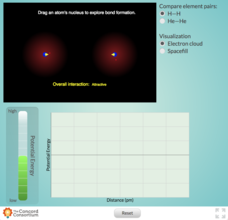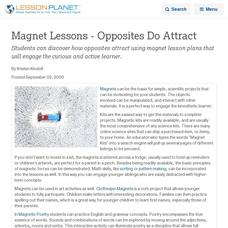Concord Consortium
Intermolecular Attractions and States of Matter
Need a solid resource for teaching about states of matter? Science scholars go with the flow in a simple interactive that shows how intermolecular attractions determine a substance's phase. Pupils take control of the level of attraction...
Curated OER
Attract or Repel?
Opposites attract with a fun science experiment on magnets. With a short paragraph on background knowledge, the lab sheet prompts third and fourth graders to choose which pairs of magnets will attract, and which pairs will repel. A...
Concord Consortium
Seeing Intermolecular Attractions
Ahh, the rules of attraction...intermolecular attraction! Introduce your chemistry crew to the other forces that influence the behavior of atoms and molecules alike with a simple interactive. Pupils push and pull polar and non-polar...
Concord Consortium
Opposites Attract
Whether they pull together or push away from one another, magnets are sure-fire pupil pleasers! Take their study of magnetism to a new level with a fun interactive. Individuals control the polarity of two spheres to observe attractive or...
Curated OER
What's the Attraction
Students sort objects based on magnetism. In this magnetism lesson, students are given a variety of objects, then predict whether the object will be attracted to a magnet and test their hypothesis as they sort the objects into "yes" and...
Curated OER
Colorado Tourist Attraction
A worksheet on Colorado tourist attractions is here for you. In it, learners select one attraction, describe it, write a short essay explaining why people should visit it, and list how many people go there each year. This worksheet would...
Curated OER
Magnets Attract
Students will be attracted to this magnetic lesson. They must decide which objects are attracted to a large horseshoe magnet, draw their own objects, then color the page. This is a great worksheet to complete to test students' prior...
Concord Consortium
Polarity and Attractive Strength
Teaching intermolecular forces can be quite a stretch! Chemistry scholars experiment with the attractive strength between polar molecules using an interactive resource. Learners test molecules of low, medium, and high polarities by...
Concord Consortium
Hydrogen Bonds: A Special Type of Attraction
How does hydrogen bonding explain ice crystals? An engaging interactive answers just that. Scholars explore how polar molecules interact and observe the changes as temperature fluctuates as well as the hydrogen bond attraction.
Concord Consortium
Factors Affecting London Dispersion Attractions
How can non-polar molecules be attracted to one another? Introduce the phenomenon of London dispersion forces to young chemists through an entertaining interactive. Pupils choose from a variety of molecular shape combinations, then pull...
Concord Consortium
Intermolecular Attractions and Boiling Point
Why do different substances have different boiling points? Through an interactive lesson, learners explore how intermolecular attractions affect boiling points. They interact with molecules through an animation and make conclusions about...
Curated OER
Slime and Intermolecular Attractions
Students explore the strength of intermolecular attractions. They make slime and compare the difference in the physical properties of sheet and powdered polyvinyl alcohol with polyvinyl acetate.
Curated OER
Placing Artificial Domiciles to Attract Bumble Bees
Students investigate how to entice bumble bees to accept artificial domiciles. They conduct research about bee biology and nest architecture, plan and construct an artificial domicile to attract bumble bee queens, and monitor and record...
Science Geek
Intermolecular Forces of Attraction
Chemists love London (dispersion forces)! Presentation begins with an explanation of intermolecular forces including hydrogen bonding, dipole-dipole attraction, and London dispersion forces. It also covers polarity and the relative...
Curated OER
Attractive Alloys
Include a lab about alloys and magnets in your fourth grade science lesson. Young scientists read the necessary background knowledge about alloys, then choose which objects (a screw, a bell, scissors, or coins) will be attracted to...
Curated OER
The Power of Magnets
Young scientists view this interactive slide show which teaches them about magnetism. Students test a variety of objects such as: a pencil, paper clip, penny, marble, and yarn to see if they can make a magnet move. Students see that the...
University of Minnesota
Chemotaxis Using C. elegans
Have you ever wondered what roundworms are like? Or what they don't like? Explore the sensory preferences of C. elegans through this controlled chemotaxis experiment. Biology class members brainstorm what substances might attract—or...
Curated OER
Metals Can be Attractive!
After reading a short paragraph about metals and magnets, young scientists circle the things they think will be attracted by a magnet. There are six objects for them to consider. A nice worksheet to help get a discussion on magnets and...
K20 LEARN
The Attraction is REAL
How attractive is your intermolecular forces lesson plan? Draw your class in with an activity that includes research, presentation, and demonstrations. Chemistry scholars work together to create claims about the each intermolecular...
Curated OER
Magnetic Attraction
In this magnets instructional activity, students fill out a chart to record what is attracted and not attracted to a magnet. Students will experiment with different items to test the magnetic attraction and record the results.
Curated OER
Magnetic Attraction And Cars
In this magnetic attraction instructional activity, students draw arrows to shoe if cars with positive and negative signs repel or attract each other, then write definitions for "attract" and "repel."
Concord Consortium
Non-Bonding
What makes helium so Noble, anyway? Explore the bonding properties of helium versus those of hydrogen using an interactive resource. Science scholars manipulate atoms of each element and observe changes in potential energy as the atoms...
Concord Consortium
Charged and Neutral Atoms
Do charged and neutral particles behave differently as they undergo phase changes? Science sleuths examine two types of attractive forces using an informative interactive. Pupils can vary the amount of Van der Waals attraction present...
Curated OER
Magnet Lessons - Opposites Do Attract
Students can discover how opposites attract using magnet lesson plans that will engage the curious and active learner.
Other popular searches
- Magnetic Attraction
- Tourist Attractions
- Capillary Attraction
- Theme Park Attractions
- Attraction and Repulsion
- Gravitational Attraction
- Interpersonal Attraction
- Molecular Attraction
- English Tourist Attractions
- Cities and Attractions
- Electric Attraction
- Suriname Tourist Attractions

























